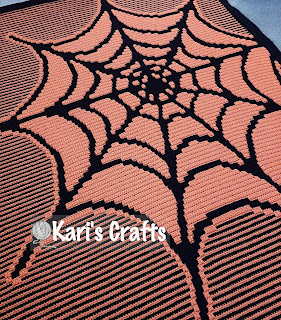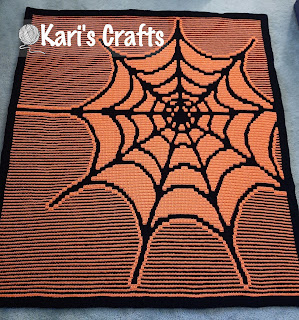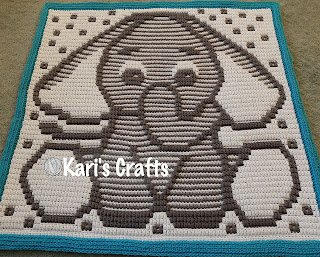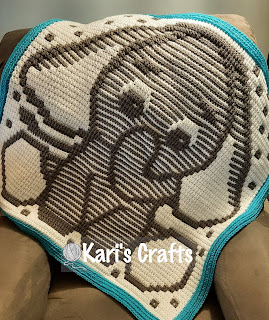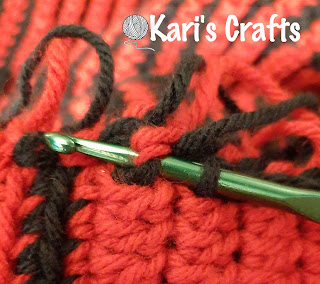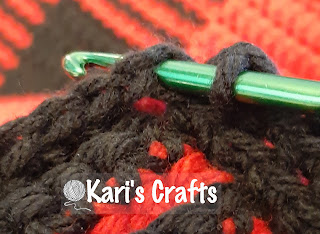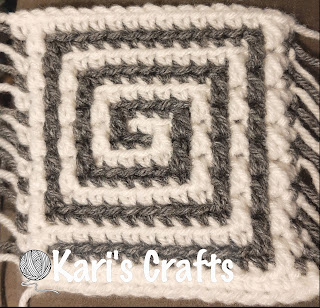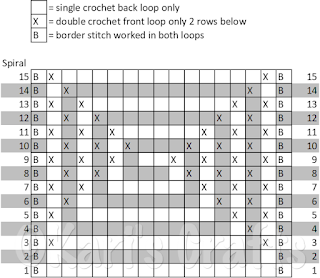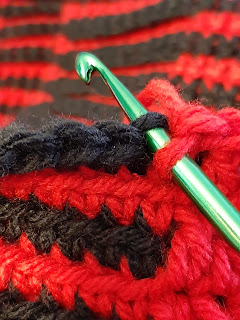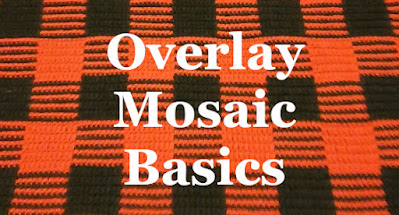I thought it would be helpful to offer a few practice graphs, especially for those that are new to overlay mosaic crochet. These are also good for making small gauge swatches to test your tension before starting a larger project. You can always use them for coasters or mug rugs when you're done. :)
So we'll start with a spiral square. You can use whatever yarn you like with an appropriate hook for the yarn. The sample shown was made with Red Heart Super Saver in white for color A and Grey Heather for color B with a size H/5mm hook. There is one border stitch on each side. These are just single crochet stitches worked into both loops of the stitch in the previous row. I start each row with a standing single crochet, but if you prefer you can attach the yarn with a slip stitch, chain 1 and single crochet into the same stitch. Remember, except for the border stitches, all single crochets are worked into the back loop only of the stitch in the previous row. All double crochets are worked into the front loop only of the stitch 2 rows below. Fasten off at the end of each row.
Written Instructions:
Row 0 (foundation row): Make 17 foundation sc or chain 18, sc in 2nd chain from hook and in each remaining chain across. Fasten off. (17 sc)
Row 1 (color A): SC, 15 scblo, SC
Row 2 (color B): SC, 15 scblo, SC
Row 3 (color A): SC, 1 dcflo, 13 scblo, 1 dcflo, SC
Row 4 (color B): SC, 1 scblo, 1 dcflo, 13 scblo, SC
Row 5 (color A): SC, 1 dcflo, 1 scblo, 1 dcflo, 11 scblo, 1 dcflo, SC
Row 6 (color B): SC, 1 scblo, 1 dcflo, 1 scblo, 1 dcflo, 9 scflo, 1 dcflo, 1 scblo, SC
Row 7 (color A): SC, 1 dcflo, 1 scblo, 1 dcflo, 1 scblo, 1 dcflo, 7 scblo, 1 dcflo, 1 scblo, 1 dcflo, SC
Row 8 (color B): SC, 1 scblo, 1 dcflo, 1 scblo, 1 dcflo, 1 scblo, 1 dcflo, 5 scblo, 1 dcflo, 1 scblo, 1 dcflo, 1 scblo, SC
Row 9 (color A): SC, 1 dcflo, 1 scblo, 1 dcflo, 1 scblo, 1 dcflo, 1 scblo, 1 dcflo, 3 scblo, 1 dcflo, 1 scblo, 1 dcflo, 1 scblo, 1 dcflo, SC
Row 10 (color B): SC, 1 scblo, 1 dcflo, 1 scblo, 1 dcflo, 1 scblo, 1 dcflo, 3 scblo, 1 dcflo, 1 scblo, 1 dcflo, 1 scblo, 1 dcflo, 1 scblo, SC
Row 11 (color A): SC, 1 dcflo, 1 scblo, 1 dcflo, 1 scblo, 1 dcflo, 5 scblo, 1 dcflo, 1 scblo, 1 dcflo, 1 scblo, 1 dcflo, SC
Row 12 (color B): SC, 1 scblo, 1 dcflo, 1 scblo, 1 dcflo, 7 scblo, 1 dcflo, 1 scblo, 1 dcflo, 1 scblo, SC
Row 13 (color A): SC, 1 dcflo, 1 scblo, 1 dcflo, 9 scblo, 1 dcflo, 1 scblo, 1 dcflo, SC
Row 14 (color B): SC, 1 scblo, 1 dcflo, 11 scblo, 1 dcflo, 1 scblo, SC
Row 15 (color A): SC, 1 dcflo, 13 scblo, 1 dcflo, SC
More practice graphs and instructions on envelope border aka double border coming soon!

